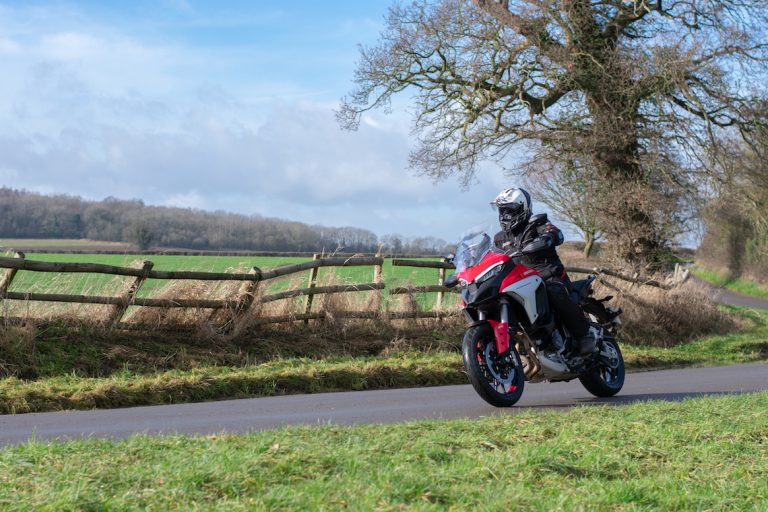Julian Challis hits the road on Ducati’s stunning new V4 S adventure bike, but is it the best Multistrada ever made?
If you were to list the people who have defined the course of modern history, you would be hard pushed to leave Steve Jobs off that list. As the driving force behind Apple, Jobs’ visionary technology has touched almost every aspect of our lives.
Yet achieving that unique position did not happen by following market trends or responding to customer demand. No, Jobs took an entirely different approach.
“People don’t know what they want until you show it to them,” he observed. “That’s why I never rely on market research. Our task is to read things that are not yet on the page.”
Whether intentionally or unwittingly, that unique ethos is embodied into the very fibre of the latest addition to Ducati’s phenomenally successful Multistrada range. If Ducati had merely relied on market research in the adventure sector, they might have either ended up chasing ever-larger capacity engines with even more power or perhaps find themselves disappearing down the rabbit hole of trying to build the perfect middleweight adventure bike that suited every possible rider. But a V4 Adventure bike? That was never on anyone’s wish list.
But sweeping along sun-dappled Cotswold roads on a fresh February morning on the new Multistrada V4 S, it’s evident that Jobs’ unique approach and Ducati’s development team were bang on the money. While it’s often easy to reach for the superlatives in a bike review, this bike is truly exceptional.
Of course, the fact that Ducati has been able to launch such a groundbreaking and technologically advanced motorcycle in the current climate is perhaps just as exceptional. In fact, the new Multistrada is an incredible achievement.
And naturally, the company’s marketing department wanted to reveal their new baby in the way that only Ducati can do. Previous spectacular launches in Tuscany and Valencia for the 1260 and 950 Multistradas set the bar high, but the V4 was about to raise it again.
Enthused by the apparent retreat of the dreaded virus, the team had planned a three-day orgy of motorcycles and landscapes. Starting from Bologna for the model presentation, we were then to be flown to Sardinia to enjoy two days of riding bliss under the pale Mediterranean sun. Perfect.
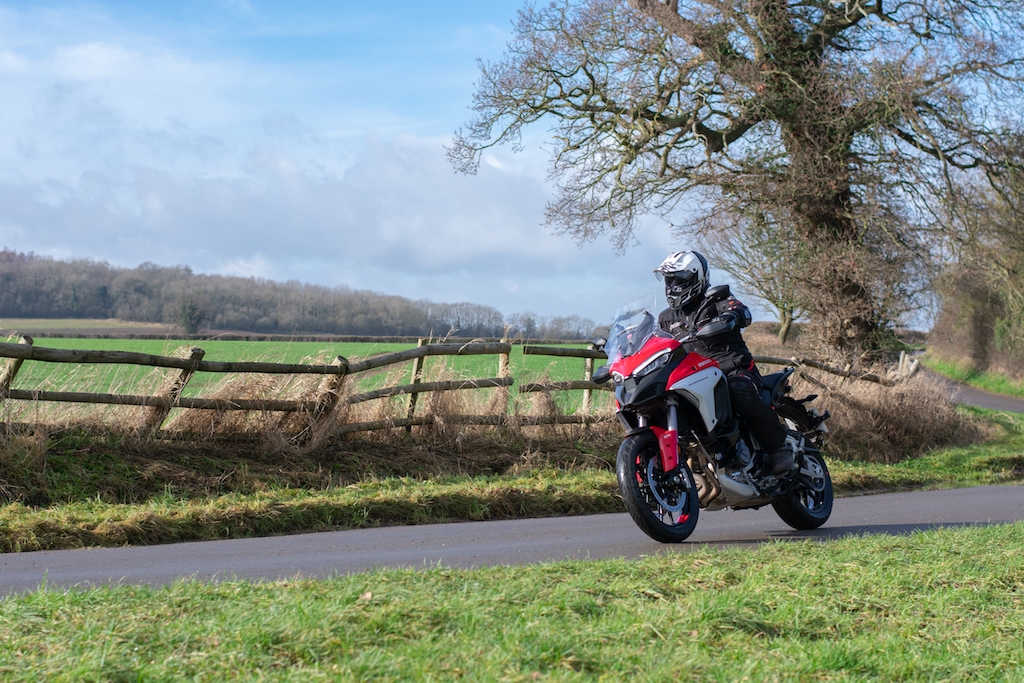
A new reality
But, as with just about everything last year, those plans disappeared like rain on a hot header pipe. Instead of nibbling on antipasto and sipping cold Chianti in Olbia, I’m pulling up outside Ducati’s UK HQ in Silverstone. And, instead of being shown around the new bike by an effusive Italian engineer, I have to remain in my van while the bike is wheeled out to me, all social interaction negated in adherence to government guidelines. But hell, with the prospect of a whole day with a Ducati V4, I can get over it.
An hour later, I’m at the ABR offices, and with the sun now peeping out, it’s a chance to look over the new V4 S while we shoot the static photos. And boy, is it a beauty. Previous generations of Multistrada have all been pretty easy on the eye, but the V4 takes it to another level. There’s still the familiar Angry Birds beak at the front, now with new Panigale style running lights. Then there’s the brushed silver radiator shrouds and the deep blood red of the upper fairing, tank, mudguard, and the rear subframe supporting the sleek back end of the machine.
Thankfully Ducati has now dropped the bizarre textured sand coloured option from previous models, so the only other colourway available is the somewhat soulless, if on-trend, Aviator Grey. Let’s be clear, red is the only acceptable option.
Other new design features include the gorgeous and aggressive vertical louvred engine vents adorning the V4 like the gill slits of a shark. There are also nods to Ducati’s MotoGP bikes in the air scoops and uber-cool winglets at the base of the fairing, framing the sweep of the front two headers. Damn, she’s pretty!
With the photos in the can, it’s time to slip my phone into the cute little tank pocket, fire up the beast, and get riding. The V4 has a keyless ignition system, but you still need the key to open the tank and seat. To start the motor, I prod the big button at the head of the tank, at which point the new 6.5” TFT comes to life with an opening sequence before settling to a much-improved new design, with white text on a black background.
The screen on the previous 1260 Multistrada was good, but certainly earned no cigar with its odd little plastic gear indicator jutting into the display like an unwanted guest at a wedding. Thankfully, it doesn’t make an appearance on the new bike.
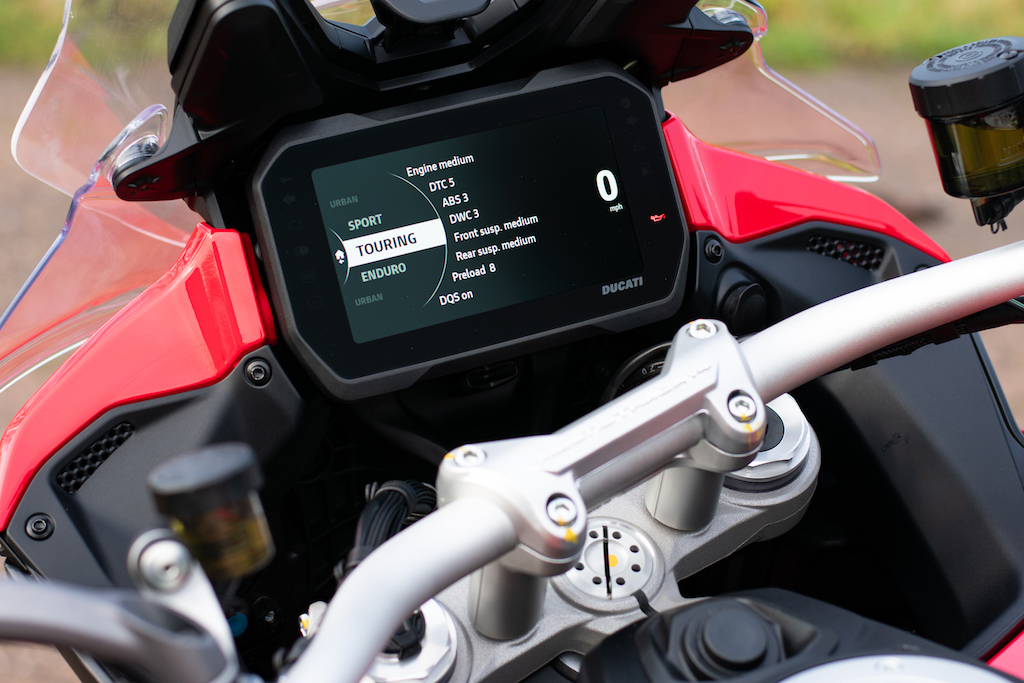
The V4 screen is neat and uncluttered, presenting clear information on the bike’s settings that can be changed from the newly designed right-hand switchgear and toggle, suitably backlit in a soft crimson hue. The layout is clear and changing the settings is refreshingly intuitive. And, thanks to the mobile phone style mineral glass that substantially reduces reflection, the display is far easier to see even in bright sun. Top marks Bologna.
Thumbing the starter on the right-hand switchgear brings the V4 motor to life with a slightly unfamiliar, if wholly enjoyable, burble from the cylinders below. Like many modern twin-cylinder machines, whether V or parallel, the V4 has a 70-degree offset crank with a twin pulse firing order. With a pair of these cylinders doing exactly the same alongside each other, the sound is a little bit like two twin-cylinder motorcycles, only better. Blip the throttle and that soft pulsating thrum becomes an intoxicating roar that is pure Panigale in adventure bike clothing.
That said, while the new V4 motor is similar to its racing sibling, it’s certainly not the same. Among a raft of other changes, from bigger cylinders to altered gearing, the most jaw-dropping move away from trusted and brand-defining technology is Ducati’s decision to ditch the hallowed desmodromic valves. The all-new Granturismo engine in the Multistrada V4 is fitted with conventional valves. I’ll just wait and allow that to sink in for a while. Conventional valves on a Ducati. Mind blown right there.
If that were not enough, the engineers have been characteristically innovative with the new valve train. It all gets rather complicated, but all we really need to know is that swapping to this system and layout means that the V4 Multistrada can go almost 10,000 miles before needing fresh oil, and an incredible 36,000 miles before needing those valves adjusting. That’s one and a half times around the world if you like a random statistic.
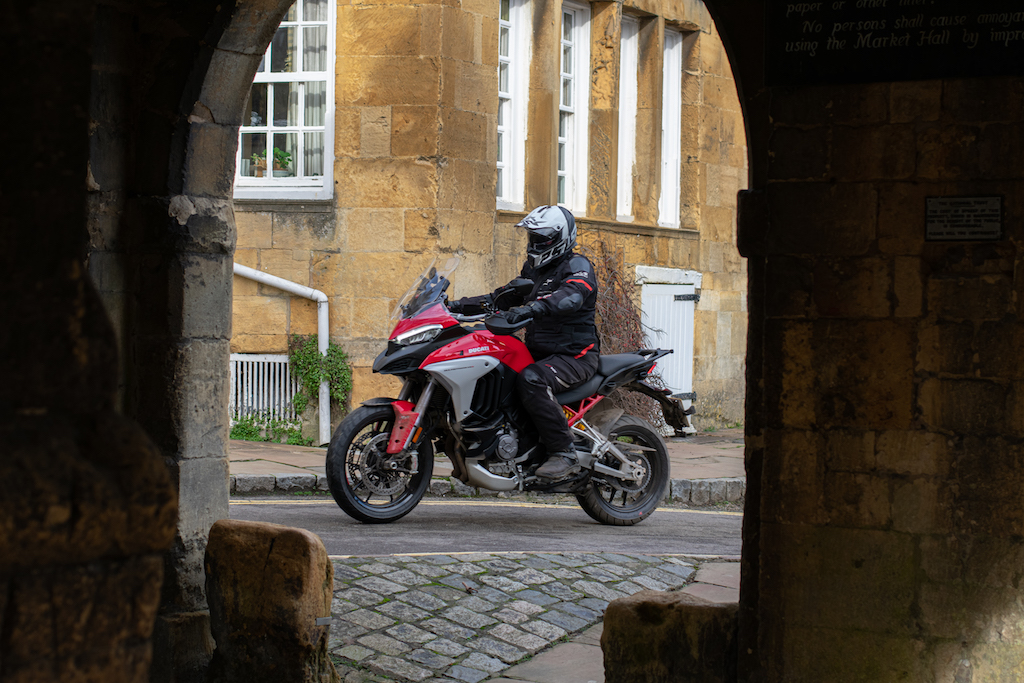
Urban jungle
Throwing a leg over the bike, the seat height is just right for me at 5’ 11”. It can be varied between 840 mm, at its lowest setting, and 860mm on high. If you are vastly outside that range, there’s a low version at 810mm or a tall seat which stands at 875mm. Pulling in the effortless hydraulic clutch and snicking into first, it’s out onto the lane and up to the A46 ahead. The bike immediately feels familiar and natural, the power delivery super smooth through the lower gears, and the balance faultless.
Ducati has spent a lot of time refining the relationship between the bars, seat and footpegs, and their efforts show. The bars have a comfortable wide and low swept profile, and they also cleverly swap to an off-road orientation by simply rolling them forwards and adjusting the levers and switchgear to pre-set positions.
We head northwest into Stratford upon Avon, and with a swift toggle on the mode switch, I select Urban from the choice of Touring, Sport, Urban and Enduro. Although the new motor is actually 104cc smaller than the outgoing 1260, it puts out more power at a blistering 170 bhp and 125Nm of torque if you fully open the taps. In Urban and Enduro modes, power is limited to better suit conditions.
Whichever mode you pick, they are termed as ‘open’, as while there are factory base settings, every single parameter can be adjusted, from traction to wheelie control, ABS to suspension settings and more. If you like to fine-tune your ride, the Ducati is almost infinitely adjustable.
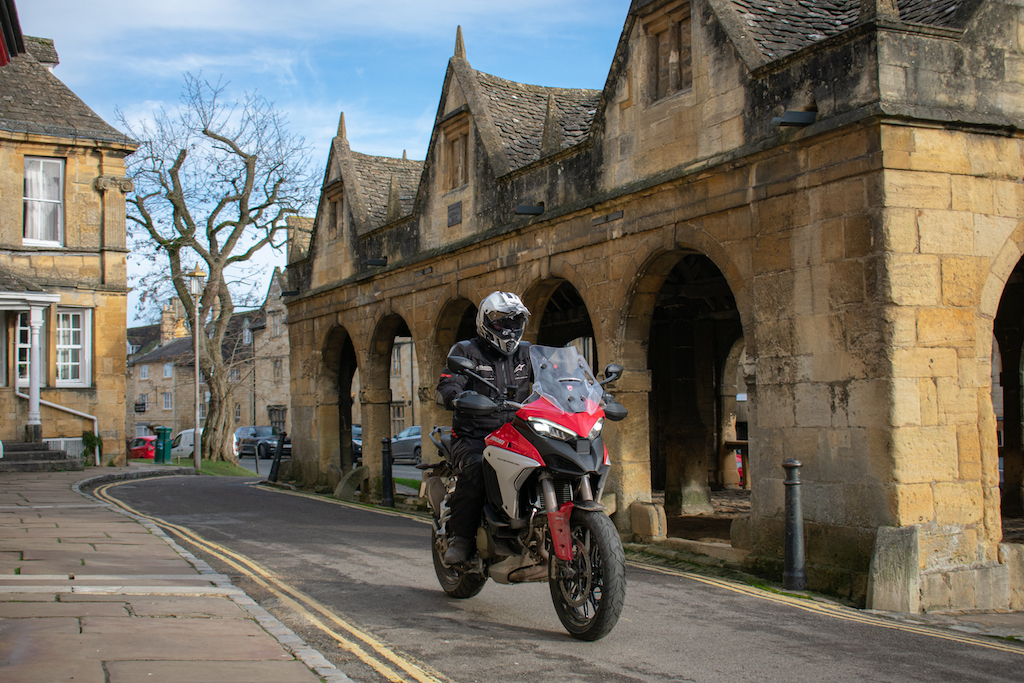
Weaving our way through the town centre traffic, it’s quite noticeable just how manoeuvrable the new V4 is. Although you might think doubling up on the number of cylinders and increasing the complexity of the lump would inevitably result in a bigger heavier unit, the exact opposite is true. At just 66.7kg, the Granturismo V4 is an incredible 1.2 kg lighter than the previous 1260 engine, 10cm lower and shorter, and only a tiny 2cm wider.
The smaller engine has also given the bike 46mm more ground clearance at 220mm. When combined with the gyroscopic effect of the reverse spinning crank, and the bike’s remarkable 218kg dry weight, the new V4 is a refreshingly effortless bike for urban riding. The ECU even cuts out the rear two cylinders on idle while you wait at the lights to reduce fuel consumption and keep things cool.
Grand tour
As the suburbs of Stratford disappear into the distance and the road opens up, I toggle the bike into Touring mode. Ducati knows that the Multistrada will spend most of its existence in this setting and it has put the most effort into ensuring all the parameters are just about perfect for long days in the saddle. The torque in the lower two gears is reduced for dependable low-speed control and the traction and wheelie control and ABS are adjusted to maintain the best possible stability and control, whether you are one or two up.
On the S model, the semi-active Skyhook system instantly adjusts the suspension to be deliberately soft and comfortable, but the clever algorithms and sensors stiffen up both back and front under braking or acceleration through anti-dive and anti-squat technology. You can adjust the bike for both the number of passengers and luggage, but if you are feeling lazy, you can just select the auto levelling option and the Skyhook technology selects the correct preload in a trice.
Ducati has even worked on optimising the induction and exhaust note to ensure that, while you can still enjoy that V4 noise, you won’t end up with a splitting headache at the end of a 400-mile or so day.

The faster roads also illustrate just how well the Ducati’s ergos and wind tunnel-developed bodywork perform at speed. Considering the screen is quite small, pulling it up to the high position with arguably the best and easiest adjustment on the market, instantly negates any negative buffeting and cocoons me in a wonderful calm bubble as the cool winter air flicks past.
The flat, relatively narrow, yet comfortable heated seat allows you to move around without slipping into the tank, while the pillion seat is similarly horizontal. Boasting better grab handles and a 25mm thicker and 40mm longer pad, your significant other is going to be very happy back there, especially as they can control their own two-setting heated seat themselves from a switch between their legs.
Our route takes us towards the north of the Cotswolds, and with the roads rapidly drying, it’s time to try Sport mode. With suitable drama, even the word ‘Sport’ is blood red as you select the mode, the screen directing you to close the throttle to allow the change. After that, it’s game on as the bike releases all the power it possesses to the whim of your wrist.
The suspension stiffens and raises, the full 170 bhp with aggressive power curve is available, and the whole bike feels like it’s just done a line of the finest Colombian. The power and noise are intoxicating as the Ducati slices through the landscape like a scalpel, the rasp from the short, slim end can following behind like a sonic chemtrail. I try to remind myself that this is an adventure bike, but really the Multistrada is so much more.
PRICE: £18,395
ENGINE: V4 Granturismo, 4 valves per cylinder, counter-rotating crankshaft, liquid-cooled
CAPACITY: 1,158 cc
GEARBOX: Six-speed
POWER: 170bhp
TORQUE: 125Nm
SUSPENSION: Front: 50 mm fully adjustable USD fork. Rear: Fully adjustable monoshock
BRAKES: Front:2x330mmdiscs with four-piston Brembo callipers. Cornering ABS. Rear: 265mm disc with Brembo two-piston calliper. Cornering ABS
WEIGHT: 243kg (wet)
TANK CAPACITY: 22l
SEAT HEIGHT: 840mm – 860mm
Framework
The stability and poise of the new V4 at whatever speeds or terrain you choose is doubtless helped by the new chassis, and again, Ducati has flown in the face of its own established USP.
The trellis frame, long the iconic feature of the Multistrada and a raft of other models for years, has been unceremoniously dumped. In its place, there’s a cast monocoque over the top of the engine which serves to connect it to the handlebars and front end, which comes equipped with 50mm Marzocchi USD forks and a new 19” front wheel.
As is common, the engine is a stressed member, with the familiar single-sided swingarm replaced in favour of a deliciously crafted conventional swingarm and left mounted Marzocchi monoshock next to a 17” rear wheel. Over the top of the yellow coils of the spring is the red tubing of the rear subframe which still maintains the trellis construction.
It’s a massive departure for Ducati to make such a fundamental change to an iconic design that purists will doubtless hate. When it feels so planted and responsive, I’m not convinced that matters.
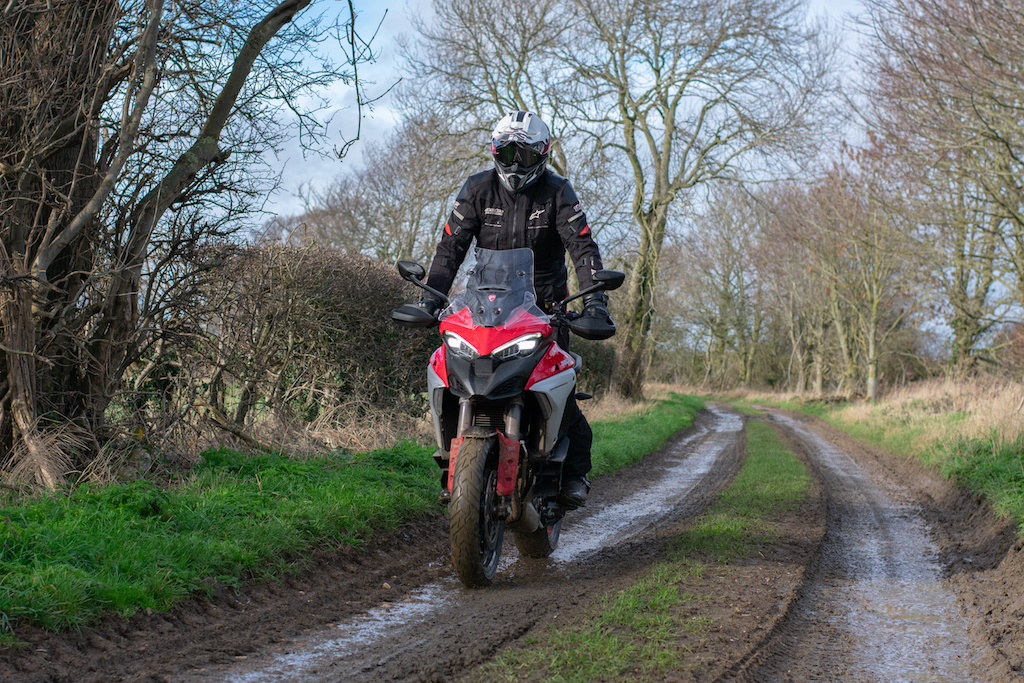
In an effort to have some semblance of a driving licence left, I turn off the blacktop for a bit of off-road testing and the Ducati rewards me with all the positive feedback and feel that the old 1260 Enduro had previously demonstrated when I rode it. Although our test bike is on cast alloys and the more road-focused Pirelli Trail 2 hoops, on gravel trails the bike is just joyful.
The Enduro mode setting delivers the perfect mix of power and control as I carve along the Cotswold lanes. The V4 has a healthy 170mm of travel up front and 10mm more at the back, and teamed with the Skyhook suspension, the bike remains stable and composed no matter what you subject it to. If I’d had the Scorpion Rally tyres and wire wheels fitted, I would have rolled forward the bars and disappeared for the rest of the day.
Full gas
We stop for lunch in the picturesque Cotswold’s town of Chipping Camden, just a few miles from the infamous Fish Hill, a positive mecca for local motorcyclists and an environment in which the big Ducati will not fail to thrive, I’m certain. The blast up the hill demonstrates all the bike’s awesome and joyful midrange power while the return down the sweeping curves of the long descent show the V4’s faultless handling, suspension and road holding.
The unexpected appearance of a slow moving hay lorry on the final pass also shows off the anchor-like stopping power of the radially mounted four-pot Brembo Stylema callipers as they grab onto the twin 330mm ventilated discs. At the rear is a twin pot unit and, mounted to a relatively large 265mm rotor, it gives a positive and dependable feel for keeping the rear of the bike in check.
With the best of the day gone. It’s time to head back home, and luckily that means heading north away from Broadway to pick up the near-deserted dual carriageways of the A46. With the return of the bike looming, I click it back into Sport mode and bury the throttle, spinning up the four cylinders till they roar like a Vulcan bomber on take-off.
While the Warwickshire landscape turns into a blur on either side of the road, the Ducati destroys the miles of tarmac like its Moto GP siblings, instantly reaching eye-watering speeds in the blink of an eye. When I’m forced to slow for the occasional roundabout, it’s just a question of tapping down the box on the quick shifter, dropping in, and then back on the gas for more miles of sensory overload.
End Game
As our end point approaches, I can’t fail to be impressed with Ducati’s efforts in not only creating this groundbreaking motorcycle but doing so in such challenging conditions. While the 1260 was undoubtedly a pretty damn impressive machine and a definite progression from the 1200 before it, the V4 takes Ducati’s Multistrada to a completely different level of performance and sophistication. The technology that is packed into the bike is truly staggering and the riding experience is all the better for every single innovation, from the self-cancelling indicators to the traction control, the cornering ABS to the blind spot detection or radar assisted cruise control.
But leaving all that aside, the thing that makes this bike truly exceptional is that V4 engine. As Steve Jobs might have predicted, I didn’t even know I wanted a V4 Adventure Bike. Now I don’t think I want anything else.
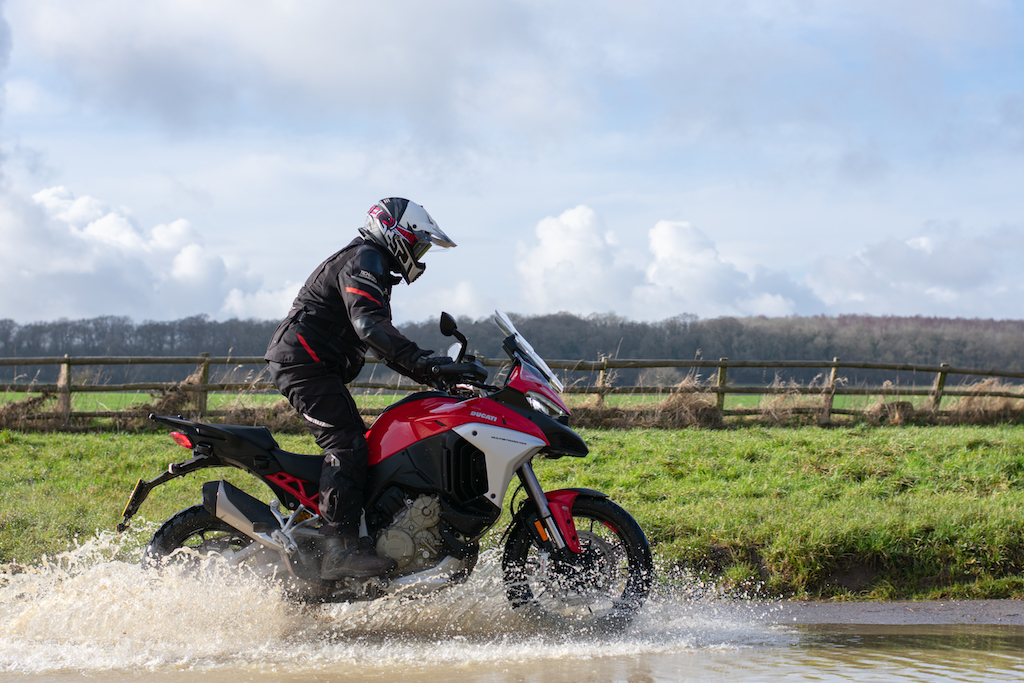
Choices
There are three versions of the Multistrada V4. First off, there’s the base model V4 with mechanical suspension but most of the other useful tech. Next is the V4 S with electronic semi-active suspension and two-colour options. Finally, there’s the all-singing, all-dancing V4 S Sport which has a fancy paint scheme, glossy wheels, an Akrapovič can, and a carbon front mudguard. For our money, choosing the stock bike would be like investing in a Saville Row suit but going without the lining.
The Sport version is like having the full suit and adding a diamanté collar. On top of the model choices, there are also four trim levels of Essential, Travel, Travel and Radar, Performance and Full. Were that not enough, there are also four accessory packs of Enduro, Touring, Urban and Performance. If you’ve got the money, honey.
New Tech
Alongside the conventional and expected technology on a top-end adventure bike, the Multistrada V4 S also gets some entirely new and innovative gadgets to aid your riding.
First off is Blind Spot Detection, a clever system that picks up any vehicles approaching in your blind spot to the right or left. If it happens, a small orange light on the edge of the mirrors illuminates to alert you. If you choose the Blind Spot Detection Plus option, the light flickers urgently if a vehicle is approaching from either side at speed. It won’t eliminate the need for a shoulder check, but it certainly helps.
The second innovation is radar-controlled cruise control. It’s a system developed for cars but adapted to work on the new Ducati. Once selected, you can choose the required distance on the TFT screen, and from that moment the system will constantly monitor your position in relation to the vehicle in front, gently adjusting the throttle and progressively braking to avoid getting too close. It genuinely works very well, but for many riders, this will be the Devil’s work and a step too far. Don’t worry, you can turn it off.
You want more? There’s always the electronic hill start, cornering lights, Bluetooth connectivity, and USB charging points.
ABR Verdict
As a commuter
Thanks to its uncanny balance and manoeuvrability, the V4 would make a great commuter if that’s your thing. But as ever, to purchase £20,000 worth of the finest Italian engineering and then leave it parked up outside work for much of its life would be a crime. This bike needs wide open spaces like the desert needs the rain.
As a weekend tourer
Buy the Ducati as a weekend tourer and pretty soon you’ll be starting the weekend on Thursday and struggling to end it by Tuesday. This bike is one of the most enjoyable bikes you will ever ride, so scratching A roads at the weekend will be the gift that keeps on giving.
As an off-roader
In full enduro trim, the V4 is even more fun off-road than the previous 1260 which I absolutely loved. The new bike has better ground clearance, better handling, better suspension, and when combined with that sublime engine and seamless technology, getting dirty on the V4 is a joy you should not miss. Just don’t high-side on a gravel road up in the Dolomites …
As a continental road tourer
When the borders are eventually reopened, and we can once again roam freely across Europe and beyond, we cannot imagine a better choice of scoot than the Multistrada V4. It’s all-day comfort and has more than enough power and performance to make the riding enjoyable from sunrise to sunset. The only downside is the raised fuel consumption from those extra cylinders, with the V4 promising 43mpg to the 1260s 54mpg. That’s good enough for about 200 miles before the tank is dry.
As an RTW overlander
OK, so on this one we’re not so sure. Despite the stratospheric service intervals, whether you would really want to subject such a beautifully made and technologically advanced motorcycle to the months and months of hard riding and less than perfect roads is questionable. While the Ducati would probably do it and come out smiling, there are without doubt better choices on the market for such a trip.
As a pillion carrier
Now we are back on safer ground and we can wholeheartedly confirm that the V4 will be just peachy as a pillion carrier, and while your partner might question the price you’ve paid for this slice of motorcycling excellence, they won’t quibble at the creature comforts of the rear perch. The seat is wide, well-padded and plenty long enough, with generous and usable grab handles. Hell, there’s even a heated seat for those chilly Alpine passes.


